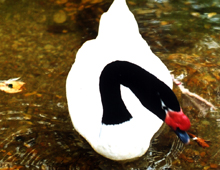Description: Black-necked swans are completely white except for their neck and head, which are black. A white stripe runs across each eye. The bill is gray with a unique red lob near the base; legs and feet are also red. The young are light gray in color and have black bills and feet, but they obtain their black and white feathers in their second year.
Size: As the smallest of their genus (Cygnus), they are often referred to as the the largest waterfowl native to South America. Black-necked swans grow to be 44-54 inches (112-137 cm) tall, 40-48 inches (100-122 cm) long and can weigh between eight and fifteen pounds (3.6-6.8 kg). Males are generally about one-third larger than the females.
Behavior: Throughout most of the year, Black- necked swans are very social, but during breeding season they become more territorial and aggressive. Males can be particularly aggressive during breeding season and will use their wings to beat their opponents. Black-necked swans spend most of their time in the water. Their legs are set far back on their bodies, which makes them excellent swimmers, but very poor walkers. They have a difficult time taking off, but once they are in the air, they are one of the fastest flying swan species. Young ride on the backs of the parents more frequently than in other swan species. Generally the cygnets (young swans) ride on the father’s back while the mother eats after incubating the eggs.
Diet: Black-necked swans are generally vegetarians, but they will also eat insects and fish spawn.
Communication: These swans do not squawk or honk, but tend to use soft, repeated whistles to communicate.
Reproduction: The breeding season is usually from July to November. Four to six eggs are laid in a nest near water and dense vegetation. Incubation period is around 36 days. The cob (male) is very protective of his pen (female) and her eggs. The fledging period is ten weeks. Couples are monogamous and males help raise the young, however, females are the sole incubators of the eggs. After the eggs hatch, males tend to the young while the females concentrate on eating to regain the weight they lost while tending the nest.
Habitat/range: They generally live in swamps, freshwater marshes, lagoons, shallow lakes and sheltered coastal seas in areas of Brazil, Bolivia, Patagonia (southern part of South America, including part of Chile and most of Argentina) and the Falkland Islands.
Status: They are listed as Least Concern on the IUCN Red List.



